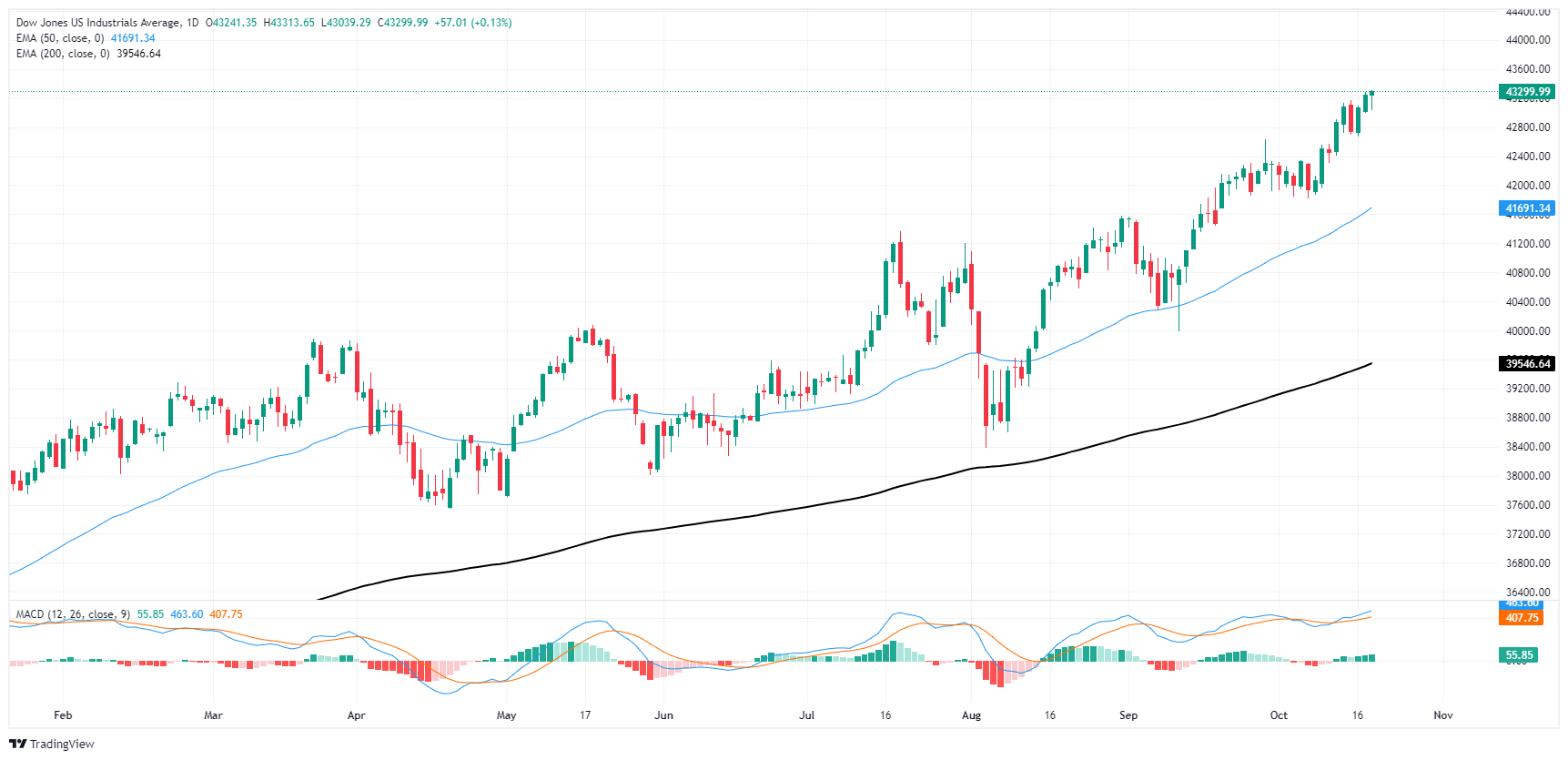- The Dow Jones tested further into record territory despite the lack of momentum.
- The third-quarter earnings season bolstered investor confidence as earnings far exceeded expectations.
- US economic data further boosted risk appetite as recession fears fade.
The Dow Jones Industrial Average (DJIA) cautiously tested higher ground on Friday, hitting another record high and keeping the needle firmly on the bullish side. Stocks are generally higher as the third-quarter earnings season sees most companies beating market expectations, and upbeat U.S. economic data this week has squashed fears of a near-term recession.
The third quarter earnings season got off to a strong start this week. The banking sector in particular outperformed market expectations, with most large commercial banks beating analyst forecasts. The AI technology bull market is also back in full swing after major chipmaker suppliers reported strong demand heading into the fourth quarter and first quarter of 2025. Markets recently reeled in stocks tech companies after fears emerged that the AI sector could be facing a slowdown, but still strong demand for chip-making materials has tilted sentiment bullish again.
US housing and construction numbers came in moderately mixed on Friday, further entrenching investors in a buying mood and further squashing any fears of an imminent economic slowdown. The US “soft landing” scenario appears to have been completely averted with growth and activity metrics easily exceeding expectations, and upbeat retail sales numbers released earlier this week further bolster the case.
Dow Jones News
Despite Friday’s meager gains, the majority of the Dow Jones board is testing green for the day. A scant third of the DJIA is trapped on the low side. Apple (AAPL) rose 1.5%, topping $235 per share after analyst reports revealed that Apple’s iPhone sales are increasing 20% in China.
On the downside, American Express (AXP) retreated 3%, falling below $277 per share after the major payments company missed market expectations for third-quarter revenue.
Dow Jones Price Forecast
Intraday bids on the Dow Jones crossed 43,300 for the first time on Friday, setting a record for the fourth time this week. The major stock index is up over 16.6% bottom-up from early 2024 lows near 37,140, and the price action has completely broken above the 200-day EMA since November 2023.
An extended push into overbought territory leaves the Dow Jones primed for a pullback to the 50-day EMA just south of the 42,000 price level. However, short interest is expected to struggle to find a foothold as equity bulls remain in full control.
Dow Jones Daily Chart
The Dow Jones FAQs
The Dow Jones Industrial Average, one of the world’s oldest stock indices, is made up of the 30 most traded securities in the United States. The index is weighted by price rather than capitalization. It is calculated by adding the prices of the securities that comprise it and dividing them by a factor, currently 0.152. The index was founded by Charles Dow, also founder of the Wall Street Journal. In recent years it has been criticized for not being sufficiently representative, since it only follows 30 companies, unlike broader indices such as the S& P 500.
There are many factors that drive the Dow Jones Industrial Average (DJIA). The main one is the aggregate performance of its component companies, revealed in quarterly corporate earnings reports. US and global macroeconomic data also contribute, influencing investor sentiment. The level of interest rates, set by the Federal Reserve (Fed), also influences the DJIA, as it affects the cost of credit, on which many companies largely depend. Therefore, inflation can be a determining factor, as well as other parameters that influence the Federal Reserve’s decisions.
The Dow Theory is a method for identifying the main trend of the stock market developed by Charles Dow. A key step is to compare the direction of the Dow Jones Industrial Average (DJIA) and the Dow Jones Transportation Average (DJTA) and only follow trends where they are both moving in the same direction. Volume is a confirmation criterion. The theory uses elements of maximum and minimum analysis. The Dow theory proposes three phases of the trend: accumulation, when the smart money begins to buy or sell; public participation, when the general public joins the trend; and distribution, when the smart money abandons the trend.
There are several ways to trade the DJIA. One of them is to use ETFs that allow investors to trade the DJIA as a single security, instead of having to buy shares of the 30 companies that comprise it. A prominent example is the SPDR Dow Jones Industrial Average ETF (DIA). Futures contracts on the DJIA allow traders to speculate on the future value of the index, and options provide the right, but not the obligation, to buy or sell the index at a predetermined price in the future. Mutual funds allow investors to purchase a portion of a diversified portfolio of DJIA securities, providing exposure to the global index.
Source: Fx Street
I am Joshua Winder, a senior-level journalist and editor at World Stock Market. I specialize in covering news related to the stock market and economic trends. With more than 8 years of experience in this field, I have become an expert in financial reporting.







